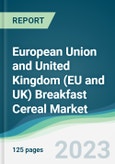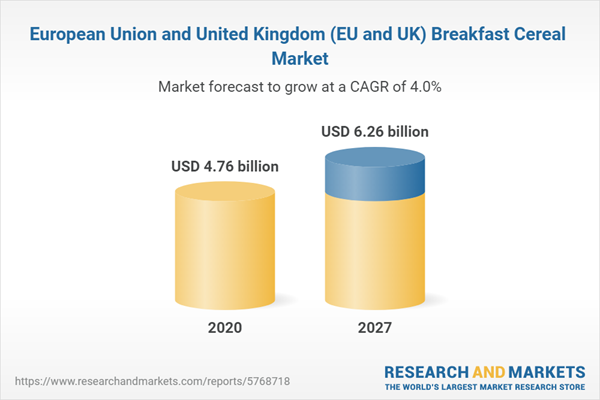The European Union and United Kingdom breakfast cereal market is projected to grow at a CAGR of 3.98% during the forecast period, reaching a market size of US$6.256 billion in 2027 from US$4.760 billion in 2020.
The increasing healthy ingredient initiatives in Europe and UK for breakfast cereals are projected to increase the demand as well as market growth in the region. Additionally, with people becoming more health conscious and preferring healthy breakfast options, the growth of the breakfast cereals market is projected to be significant in the coming years. Furthermore, nutritional breakfast cereal product launches and consumer-friendly services offered by the players in the region are also expected to fuel the market growth. For instance, Nestlé Cereals, a UK subsidiary of the multinational food corporation announced the introduction of Cheerios Vanilla O's, low-sugar cereal with no artificial colors or flavors, in October 2021. The new cereal's major component is whole grains, which are considered to be non-HFSS (high in fat, salt, or sugar) following new UK government standards. Similarly, grain-free and soy-free, BRAVE Super Hoops introduced the first cereal produced from peas and chickpeas, two of the most environmentally friendly sources of protein, in August 2022. Super Hoops, in contrast to regular cereals, don't cause a surge in blood sugar since they use low-carb and no-sugar components that provide clean energy, keep people satisfied for longer, and aid in long-term weight control and mental clarity.Based on type, the EU+UK breakfast cereal market is divided into hot cereal and ready-to-eat cereal. Ready-to-eat cereals majorly consisting of wheat and corn are more popular in EU countries as they are much more conveniently consumed in comparison to traditional hot-cooked cereals. Furthermore, the COVID-19 pandemic pushed the segment growth forward owing to the panic buying of various household items, which has further boosted the market revenue in the forecast period. Moreover, the EU region is experiencing a significant change in the food habit and dietary patterns of the population, especially among the younger population. Ready-to-eat cereal in comparison to hot cereals provides a higher nutrition intake of vitamins, and minerals and satisfies hunger for a longer period. Owing to the rich health benefits provided by ready-to-eat cereals, various companies are introducing new and innovative products related to ready-to-eat breakfast cereals. For instance, according to Crispy-Fantasy’s announcement, in May 2022, the European start-up launched its first line of ‘Junk Free’ ready-to-eat cereals products consisting of natural ingredients such as pea protein. Additionally, in August 2022, Nestle launched two new ready-to-eat cereal products in its Little Steps Multigrain Chain of cereals. The product comes with no added sugar and consists of essential nutrients such as iron, such major product launches coupled with growing preferences of people for healthy and high-nutrition breakfast have propelled the demand and consumption of ready-to-eat cereal in the EU and its major cereal consumers thereby positively impacting the market growth during the forecast period.
Healthy breakfast cereal initiatives and increased product launches are driving the market growth.
The increasing number of healthy ingredients coupled with affordability and sustainable business practices is projected to boost the demand for breakfast cereals in Europe. According to European Breakfast Cereal Association (CEEREAL), the association along with the oat milling industry laid out commitments for achieving sustainable food systems across Europe. For instance, CEEREAL members have reduced the sugar content in breakfast cereals by 10.2% along with increasing the fiber and whole grain contents by 8.9% and 17.2% respectively between 2015 and 2020. Moreover, responsible advertising and sustainable agriculture practices were two of the core commitments laid out by the CEEREAL association. Furthermore, the Association of Cereal Food Manufacturers (ACFM) provides information to consumers, and healthcare professionals among others in the UK about breakfast cereals through a Breakfast Cereal Information Service (BCIS). This has propelled businesses to constantly invest to improve their earnings to obtain superior solutions and more dependable results for a demanding and developing breakfast cereal market. For example, starting with a chocolate flavor made with unsweetened cacao powder, eight grams of plant-based protein, and at least 50% less sugar than existing brands on the market, Crispy Fantasy successfully unveiled a cereal breakfast product that caters to the mass consumer via DTC and Amazon in the UK in May 2022.COVID-19 impact on the EU and UK breakfast cereal market
Since the pandemic altered consumer dietary habits, the demand for breakfast cereals immediately began to rise. The robust outbreak of the virus and its exponential spread resulted in the implementation of nationwide lockdowns across the region. Physical shutdown, restricted movement, and lockdown uncertainties created consciousness among people, resulting in panic stockpiling of food and beverage items. The reliance on shelf-stable food products was at the forefront of COVID-19 eating habits as panic buying saw many customers store items like breakfast cereals and other packaged food. According to Kellogg's, the pandemic's increased demand for packaged meals for at-home consumption was a major factor in the expansion of its cereal segment’s net sales in Europe.Furthermore, the incorporation of physical and digital operational processes among retail chains, and modifications to the retailing industry, including steady expansion of sales through e-commerce websites and other mobile devices applications further developed market growth in 2020. Additionally, customers aimed to buy specialized products to boost their immune systems, treat themselves or reclaim a sense of familiarity, and these products readily became staples for the daily routine under lockdown. Moreover, businesses modified their strategy and began working with and investing in innovative products in response to the growth prospects in the breakfast cereal market. For instance, Weetabix Ltd. announced in August 2020 that it would spend an additional £1.65 million on marketing in 2020 as people who are usually confined to their homes choose to eat more cereal. From a budgeted £11 million, the hike increased its yearly spending by 15%, suggesting that its brand investment in 2020 would then increase 30% annually.
Market Segmentation:
By Type
- Hot Cereal
- Ready-to-eat Cereal
By Product
- Corn-based Breakfast Cereal
- Others
By Distribution Channel
- Online
- Offline
- Supermarkets
- Convenience Stores
- Others
By Country
- Germany
- France
- United Kingdom
- Spain
- Italy
- Netherlands
- Switzerland
- Others
Table of Contents
1. INTRODUCTION1.1. Market Overview
1.2. Market Definition
1.3. Scope of the Study
1.4. Market Segmentation
1.5. Currency
1.6. Assumptions
1.7. Base, and Forecast Years Timeline
2. RESEARCH METHODOLOGY
2.1. Research Data
2.2. Sources
2.3. Research Design
3. EXECUTIVE SUMMARY
3.1. Research Highlights
4. MARKET DYNAMICS
4.1. Market Driver
4.2. Market Restraints
4.3. Porter's Five Forces Analysis
4.3.1. Bargaining Power of End-Users
4.3.2. Bargaining Power of Buyers
4.3.3. Threat of New Entrants
4.3.4. Threat of Substitutes
4.3.5. Competitive Rivalry in the Industry
4.4. Industry Value Chain Analysis
5. EU and UK BREAKFAST CEREAL MARKET, BY TYPE
5.1. Introduction
5.2. Hot Cereal
5.3. Ready-To-Eat Cereal
6. EU and UK BREAKFAST CEREAL MARKET, BY PRODUCT
6.1. Introduction
6.2. Corn-based Breakfast Cereal
6.3. Others
7. EU and UK BREAKFAST CEREAL MARKET, BY DISTRIBUTION CHANNEL
7.1. Online
7.2. Offline
7.2.1. Supermarkets
7.2.2. Convenience Stores
7.2.3. Others
8. EU and UK BREAKFAST CEREAL MARKET, BY COUNTRY
8.1. Introduction
8.2. Germany
8.3. France
8.4. United Kingdom
8.5. Spain
8.6. Italy
8.7. Netherlands
8.8. Switzerland
8.9. Others
9. COMPETITIVE ENVIRONMENT AND ANALYSIS
9.1. Major Players and Strategy Analysis
9.2. Emerging Players and Market Lucrativeness
9.3. Mergers, Acquisitions, Agreements, and Collaborations
9.4. Vendor Competitiveness Matrix
10. COMPANY PROFILES
10.1. General Mills Inc.
10.2. Nestle S.A.
10.3. Dr. Oetker
10.4. Weetabix Ltd.
10.5. Associated British Foods plc
10.6. PepsiCo, Inc.
10.7. J Sainsbury plc
10.8. The Kellogg Company
10.9. Doves Farm Ltd.
Companies Mentioned
- General Mills Inc.
- Nestle S.A.
- Dr. Oetker
- Weetabix Ltd.
- Associated British Foods plc
- PepsiCo, Inc.
- J Sainsbury plc
- The Kellogg Company
- Doves Farm Ltd.
Methodology

LOADING...
Table Information
| Report Attribute | Details |
|---|---|
| No. of Pages | 125 |
| Published | April 2023 |
| Forecast Period | 2020 - 2027 |
| Estimated Market Value ( USD | $ 4.76 billion |
| Forecasted Market Value ( USD | $ 6.26 billion |
| Compound Annual Growth Rate | 3.9% |
| Regions Covered | Europe, United Kingdom |
| No. of Companies Mentioned | 9 |









